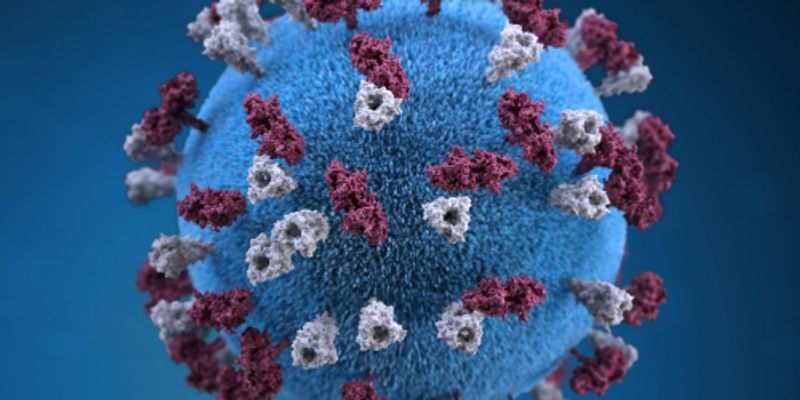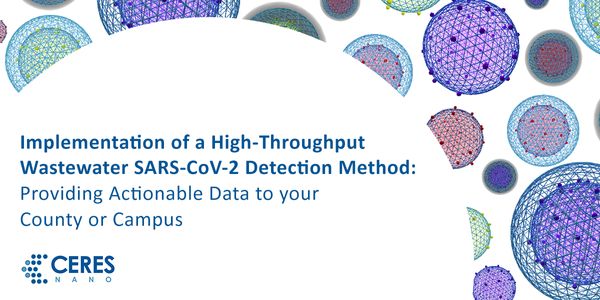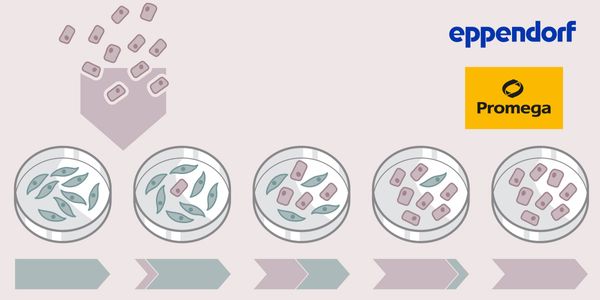Viral Genomics
Viral genomics uses advanced analytical technologies to study the biology of disease-causing viruses at a genetic level. The aim of viral genomics is to better understand how viruses interact with their hosts and how infections spread through communities. This enables drug and vaccine development efforts as well as informing public health policies.
-
OCT 13, 2021 | 1:30 PMOne significant challenge with SARS-CoV-2 wastewater monitoring is the lack of optimized and standardized sample processing steps, from sample collection to RNA detection. Viral concentratio...Speaker: Dominic O'Neil, MS, MBA , Colin Donohoe, PhDSEP 29, 2021 | 11:59 PMCas9 based therapeutics have the potential to revolutionize the treatment of genetic diseases. However, safe and effective methods for delivering Cas9 protein, gRNA and donor DNA need to be...SEP 22, 2021 | 9:00 AMCells of the liver and pancreas are highly polarized and well differentiated, contributing to food digestion through the secretion of lipid emulsifying bile, and proteolytic juice into the g...SEP 09, 2021 | 10:30 AMThe ongoing COVID-19 pandemic has elevated the need for reliable, cost-effective means for widespread virus detection. This webinar will explore two distinct approaches for isolating viral R...Speaker: Nicolas Caffarelli , Kan Saito, PhDSEP 09, 2021 | 12:00 AMAnalysis of community wastewater has been shown to be an effective method for tracking the prevalence of SARS-COV-2. Our group has developed techniques for sequencing a portion of the SARS-C...SEP 09, 2021 | 12:00 AMEarly detection is critical for prompt and effective treatment of acute infectious diseases. For tick-borne diseases (TBD), the lack of accurate early diagnosis can result in delayed treatme...SEP 09, 2021 | 12:00 AMWe currently do not have effective vaccines or antiviral drugs for most of the viral diseases that afflict humans. Antiviral therapies that enable long-term control over human immunodeficien...SEP 09, 2021 | 12:00 AMRibonucleic acid (RNA) has a breathtaking variety of biological functions, which far exceeds its classical role as a carrier of genetic information. The repertoire of this versatile molecule...SEP 08, 2021 | 10:30 AMVaricella zoster virus (VZV) causes two clinically distinct forms of disease, varicella and herpes zoster. These forms can each present with multiple manifestations ranging from lesions incl...Speaker: Jon Armstrong, MScSEP 08, 2021 | 7:30 AMMicrobes are recently recognized as driving the energy and nutrient transformations that fuel Earth’s ecosystems in soils, oceans and humans. Where studied, viruses appear to modulate...SEP 08, 2021 | 12:00 AMThe Human Microbiome Project was conceived almost 15 years ago, as an extension of the Human Genome Project, to explore the diversity of human-associated microorganisms at multiple body site...SEP 07, 2021 | 9:00 AMInnate and adaptive immunity mechanisms provide antiviral protection in mammals. In this talk, I shall present recent findings from my lab and collaborators revealing a distinct form of mamm...SEP 07, 2021 | 12:00 AMNagy is a Professor in the Department of Plant Pathology, University of Kentucky. Dr. Nagy studies the functions of host proteins and lipids in viral RNA replication. The Nagy lab is using a...SEP 07, 2021 | 12:00 AMThe Coronavirus disease 2019 (COVID-19) pandemic poses an unprecedented challenge for public health, which is caused by infection of severe acute respiratory syndrome coronavirus 2 (SARS-CoV...AUG 31, 2021 | 9:00 AMDate: July 07, 2021 Time: 8:00am (PDT), 11:00am (EDT) The DNA damage response is extremely crucial in maintaining genomic integrity. Failure to repair damaged DNA can result in the propagati...AUG 25, 2021 | 12:00 AMOver 40 tandem repeats undergo expansion events that lead to neurological disease. This number is likely an underestimate as many repeats are difficult to amplify using existing short read s...Speaker: Paul Valdmanis, PhDJUL 22, 2021 | 4:15 PMGenome editing technologies have enabled the precise manipulation of DNA sequences at targeted sites to achieve therapeutic effects. Engineered endonucleases like CRISPR-Cas9 institute site-...JUL 22, 2021 | 3:30 PMLearning Objectives: 1. Delivery vehicles for the Cas9 RNP 2. Gene editing after a direct tissue injection 3. New linkers for conjugating proteins to polymers...JUL 22, 2021 | 12:45 PMGene editing technologies such as CRISPR/Cas9 have greater flexibility and high efficiency. CRISPR technology enables targeted insertion of transgenes at the desired locus and has the abilit...JUL 22, 2021 | 11:00 AMHuman T cells are critical effectors of immune protection from infections, autoimmune pathology, and cancer immunotherapy. We use CRISPR-mediated gene editing in primary human T cells to sys...JUN 29, 2021 | 8:00 AMDate: June 29, 2021 Time: 08:00am PDT As the SARS-CoV-2 virus that causes COVID-19 keeps mutating, there is a growing need to sequence the viral genome from many COVID-19-positive samples to...JUN 16, 2021 | 11:00 AMDate: June 16, 2021 Time: 11:00am (PDT), 2:00pm (EDT) Large-scale wastewater surveillance can be used to help communities monitor infection dynamics for SARS-CoV-2. Wide-spread implementatio...JUN 09, 2021 | 7:00 AMDate: June 9, 2021 Time: 09 June 2021, 7am PDT, 10am EDT, 4pm CEST cells with dramatic implications on the validity of past cell culture related research. The fact that at least 509 cell lin...JUN 02, 2021 | 8:00 AMDate: June 2, 2021 Time: 8:00am (PDT), 11:00am (EDT) In this introduction Kelly Hunter will address the first Learning Objective. He will cover i) a range of digital pathology and tissue mul...Speaker: Kelly Hunter, BSc Biochemistry, MSc Genomics Medicine , Dr. Graham Taylor, BSc, Ph.DSponsored By: Leica Biosystems
OCT 13, 2021 | 1:30 PM
One significant challenge with SARS-CoV-2 wastewater monitoring is the lack of optimized and standardized sample processing steps, from sample collection to RNA detection. Viral concentratio...
Speaker:
Dominic O'Neil, MS, MBA
, Colin Donohoe, PhD
SEP 29, 2021 | 11:59 PM
Cas9 based therapeutics have the potential to revolutionize the treatment of genetic diseases. However, safe and effective methods for delivering Cas9 protein, gRNA and donor DNA need to be...
SEP 22, 2021 | 9:00 AM
Cells of the liver and pancreas are highly polarized and well differentiated, contributing to food digestion through the secretion of lipid emulsifying bile, and proteolytic juice into the g...
SEP 09, 2021 | 10:30 AM
The ongoing COVID-19 pandemic has elevated the need for reliable, cost-effective means for widespread virus detection. This webinar will explore two distinct approaches for isolating viral R...
Speaker:
Nicolas Caffarelli
, Kan Saito, PhD
SEP 09, 2021 | 12:00 AM
Analysis of community wastewater has been shown to be an effective method for tracking the prevalence of SARS-COV-2. Our group has developed techniques for sequencing a portion of the SARS-C...
SEP 09, 2021 | 12:00 AM
Early detection is critical for prompt and effective treatment of acute infectious diseases. For tick-borne diseases (TBD), the lack of accurate early diagnosis can result in delayed treatme...
SEP 09, 2021 | 12:00 AM
We currently do not have effective vaccines or antiviral drugs for most of the viral diseases that afflict humans. Antiviral therapies that enable long-term control over human immunodeficien...
SEP 09, 2021 | 12:00 AM
Ribonucleic acid (RNA) has a breathtaking variety of biological functions, which far exceeds its classical role as a carrier of genetic information. The repertoire of this versatile molecule...
SEP 08, 2021 | 10:30 AM
Varicella zoster virus (VZV) causes two clinically distinct forms of disease, varicella and herpes zoster. These forms can each present with multiple manifestations ranging from lesions incl...
Speaker:
Jon Armstrong, MSc
SEP 08, 2021 | 7:30 AM
Microbes are recently recognized as driving the energy and nutrient transformations that fuel Earth’s ecosystems in soils, oceans and humans. Where studied, viruses appear to modulate...
SEP 08, 2021 | 12:00 AM
The Human Microbiome Project was conceived almost 15 years ago, as an extension of the Human Genome Project, to explore the diversity of human-associated microorganisms at multiple body site...
SEP 07, 2021 | 9:00 AM
Innate and adaptive immunity mechanisms provide antiviral protection in mammals. In this talk, I shall present recent findings from my lab and collaborators revealing a distinct form of mamm...
SEP 07, 2021 | 12:00 AM
Nagy is a Professor in the Department of Plant Pathology, University of Kentucky. Dr. Nagy studies the functions of host proteins and lipids in viral RNA replication. The Nagy lab is using a...
SEP 07, 2021 | 12:00 AM
The Coronavirus disease 2019 (COVID-19) pandemic poses an unprecedented challenge for public health, which is caused by infection of severe acute respiratory syndrome coronavirus 2 (SARS-CoV...
AUG 31, 2021 | 9:00 AM
Date: July 07, 2021 Time: 8:00am (PDT), 11:00am (EDT) The DNA damage response is extremely crucial in maintaining genomic integrity. Failure to repair damaged DNA can result in the propagati...
AUG 25, 2021 | 12:00 AM
Over 40 tandem repeats undergo expansion events that lead to neurological disease. This number is likely an underestimate as many repeats are difficult to amplify using existing short read s...
Speaker:
Paul Valdmanis, PhD
JUL 22, 2021 | 4:15 PM
Genome editing technologies have enabled the precise manipulation of DNA sequences at targeted sites to achieve therapeutic effects. Engineered endonucleases like CRISPR-Cas9 institute site-...
JUL 22, 2021 | 3:30 PM
Learning Objectives: 1. Delivery vehicles for the Cas9 RNP 2. Gene editing after a direct tissue injection 3. New linkers for conjugating proteins to polymers...
JUL 22, 2021 | 12:45 PM
Gene editing technologies such as CRISPR/Cas9 have greater flexibility and high efficiency. CRISPR technology enables targeted insertion of transgenes at the desired locus and has the abilit...
JUL 22, 2021 | 11:00 AM
Human T cells are critical effectors of immune protection from infections, autoimmune pathology, and cancer immunotherapy. We use CRISPR-mediated gene editing in primary human T cells to sys...
JUN 29, 2021 | 8:00 AM
Date: June 29, 2021 Time: 08:00am PDT As the SARS-CoV-2 virus that causes COVID-19 keeps mutating, there is a growing need to sequence the viral genome from many COVID-19-positive samples to...
JUN 16, 2021 | 11:00 AM
Date: June 16, 2021 Time: 11:00am (PDT), 2:00pm (EDT) Large-scale wastewater surveillance can be used to help communities monitor infection dynamics for SARS-CoV-2. Wide-spread implementatio...
JUN 09, 2021 | 7:00 AM
Date: June 9, 2021 Time: 09 June 2021, 7am PDT, 10am EDT, 4pm CEST cells with dramatic implications on the validity of past cell culture related research. The fact that at least 509 cell lin...
JUN 02, 2021 | 8:00 AM
Date: June 2, 2021 Time: 8:00am (PDT), 11:00am (EDT) In this introduction Kelly Hunter will address the first Learning Objective. He will cover i) a range of digital pathology and tissue mul...
Speaker:
Kelly Hunter, BSc Biochemistry, MSc Genomics Medicine
, Dr. Graham Taylor, BSc, Ph.D
Sponsored By: Leica Biosystems























